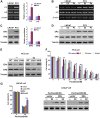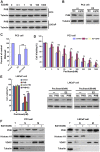Induction of paclitaxel resistance by ERα mediated prohibitin mitochondrial-nuclear shuttling
- PMID: 24376711
- PMCID: PMC3871534
- DOI: 10.1371/journal.pone.0083519
Induction of paclitaxel resistance by ERα mediated prohibitin mitochondrial-nuclear shuttling
Abstract
Paclitaxel is a drug within one of the most promising classes of anticancer agents. Unfortunately, clinical success of this drug has been limited by the insurgence of cellular resistance. To address this, Paclitaxel resistance was modeled in an in vitro system using estrogen treated prostate cancer cells. This study demonstrates that emerging resistance to clinically relevant doses of Paclitaxel is associated with 17-β-estradiol (E2) treatment in PC-3 cells, but not in LNCaP cells. We found that small interfering RNA mediated knockdown of ERα lead to a decrease in E2 induced Paclitaxel resistance in androgen-independent cells. We also showed that ERα mediated the effects of estrogen, thereby suppressing androgen-independent cell proliferation and mediating Paclitaxel resistance. Furthermore, E2 promoted Prohibitin (PHB) mitochondrial-nucleus translocation via directly mediation of ERα, leading to an inhibition of cellular proliferation by PHB. Additionally, restoration of Paclitaxel sensitivity by ERα knockdown could be overcome by PHB overexpression and, conversely, PHB knockdown decreased E2 induced Paclitaxel resistance. These findings demonstrate that PHB lies downstream of ERα and mediates estrogen-dependent Paclitaxel resistance signaling cascades.
Conflict of interest statement
Figures






Similar articles
-
Estrogen receptor α attenuates therapeutic efficacy of paclitaxel on breast xenograft tumors.Breast Cancer Res Treat. 2012 Aug;134(3):969-80. doi: 10.1007/s10549-012-1994-8. Epub 2012 Feb 29. Breast Cancer Res Treat. 2012. PMID: 22374518
-
Activation of estrogen receptor α by estradiol and cisplatin induces platinum-resistance in ovarian cancer cells.Cancer Biol Ther. 2017 Sep 2;18(9):730-739. doi: 10.1080/15384047.2016.1235656. Epub 2016 Sep 30. Cancer Biol Ther. 2017. PMID: 27689466 Free PMC article.
-
Neuroglobin overexpression induced by the 17β-Estradiol-Estrogen receptor-α Pathway reduces the sensitivity of MCF-7 Breast cancer cell to paclitaxel.IUBMB Life. 2016 Aug;68(8):645-51. doi: 10.1002/iub.1522. Epub 2016 Jun 16. IUBMB Life. 2016. PMID: 27312786
-
A repressive role for prohibitin in estrogen signaling.Mol Endocrinol. 2008 Feb;22(2):344-60. doi: 10.1210/me.2007-0400. Epub 2007 Oct 11. Mol Endocrinol. 2008. PMID: 17932104 Free PMC article.
-
Genomic responses from the estrogen-responsive element-dependent signaling pathway mediated by estrogen receptor alpha are required to elicit cellular alterations.J Biol Chem. 2009 May 29;284(22):15277-88. doi: 10.1074/jbc.M900365200. Epub 2009 Mar 24. J Biol Chem. 2009. PMID: 19321454 Free PMC article.
Cited by
-
Prohibitin: A hypothetical target for sex-based new therapeutics for metabolic and immune diseases.Exp Biol Med (Maywood). 2019 Feb;244(2):157-170. doi: 10.1177/1535370219828362. Epub 2019 Feb 4. Exp Biol Med (Maywood). 2019. PMID: 30717609 Free PMC article. Review.
-
[The establishment of Raji drug-resistant cell line and analyses of prohibitin and miR-27a expression].Zhonghua Xue Ye Xue Za Zhi. 2015 Apr;36(4):326-30. doi: 10.3760/cma.j.issn.0253-2727.2015.04.015. Zhonghua Xue Ye Xue Za Zhi. 2015. PMID: 25916297 Free PMC article. Chinese.
-
Prevention effect of rare ginsenosides against stress-hormone induced MTOC amplification.Oncotarget. 2016 Jun 7;7(23):35144-58. doi: 10.18632/oncotarget.9059. Oncotarget. 2016. PMID: 27147573 Free PMC article.
-
Prohibitions in the meta-inflammatory response: a review.Front Mol Biosci. 2024 May 15;11:1322687. doi: 10.3389/fmolb.2024.1322687. eCollection 2024. Front Mol Biosci. 2024. PMID: 38813101 Free PMC article. Review.
-
The mitochondrial unfolded protein response and mitohormesis: a perspective on metabolic diseases.J Mol Endocrinol. 2018 Oct 1;61(3):R91-R105. doi: 10.1530/JME-18-0005. J Mol Endocrinol. 2018. PMID: 30307158 Free PMC article. Review.
References
-
- Seruga B, Tannock IF (2011) Chemotherapy-based treatment for castration-resistant prostate cancer. J Clin Oncol 29: 3686–3694. - PubMed
-
- Rodriguez-Antona C (2010) Pharmacogenomics of paclitaxel. Pharmacogenomics 11: 621–623. - PubMed
-
- Doyle-Lindrud S (2012) Managing side effects of the novel taxane cabazitaxel in castrate-resistant prostate cancer. Clin J Oncol Nurs 16: 286–291. - PubMed
-
- Devlin HL, Mudryj M (2009) Progression of prostate cancer: multiple pathways to androgen independence. Cancer Lett 274: 177–186. - PubMed
Publication types
MeSH terms
Substances
LinkOut - more resources
Full Text Sources
Other Literature Sources
Miscellaneous

